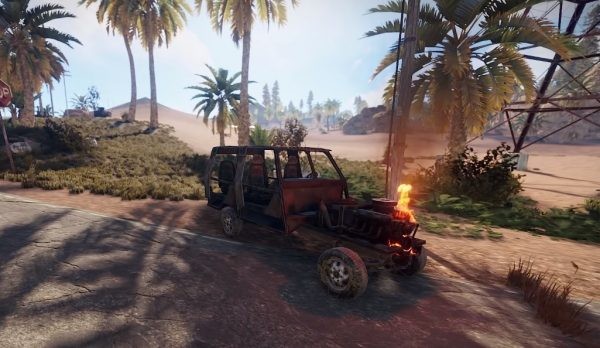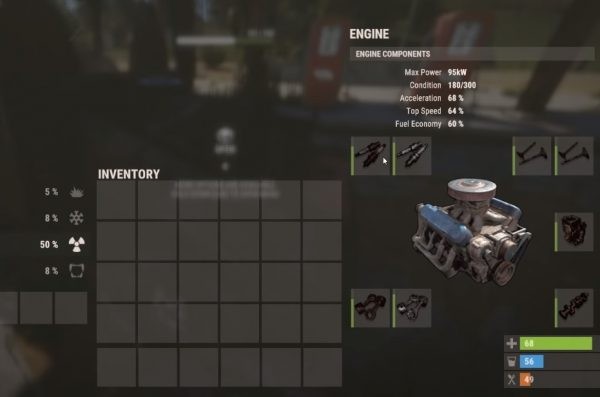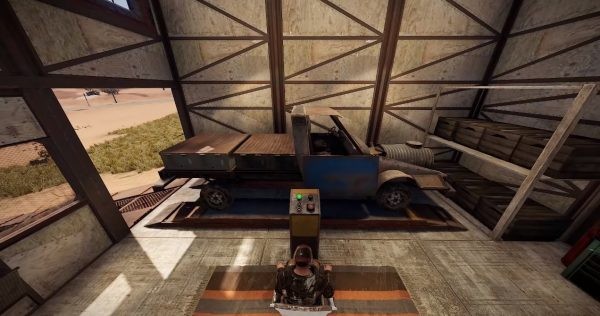Modular Vehicles have revolutionized transportation in Rust, offering players unprecedented mobility and customization options. However, these vehicles are susceptible to damage and require regular maintenance to keep them running efficiently. If you’re wondering how to repair a car in Rust, this guide will walk you through everything you need to know, from finding a damaged chassis to replacing crucial engine components and utilizing vehicle lifts for extensive repairs and upgrades.
Finding a Damaged Vehicle Chassis
Your journey to car ownership in Rust begins with locating a vehicle chassis. These can be found scattered along roadsides across the map. Keep an eye out for smoke and sparks emanating from these locations, as this visual cue indicates the presence of a damaged vehicle awaiting repair. Often, these chassis will already have some modules attached, offering a starting point for your vehicular endeavors. These pre-attached modules might be damaged and require repair themselves, using materials like Metal Fragments, High-Quality Metal, and Wood.
Gathering Essential Engine Parts for Repair
Before you can drive your newly acquired chassis, you’ll need to address the most crucial aspect of car repair in Rust: the engine. A functional engine requires several key components. These parts can be obtained through various methods, including purchasing them from vendors, looting them from toolboxes found in the world, or crafting them yourself if you have the blueprints. Remember that engine parts come in low, medium, and high-quality variants, each affecting the performance and longevity of your vehicle. Researching engine parts at a research table will unlock crafting recipes, allowing for self-sufficiency in vehicle maintenance. The fundamental engine components you’ll need to repair a car in Rust include:
- Spark Plug: Essential for ignition.
- Carburetor: Regulates fuel and air mixture.
- Shift Stick/Crankshaft: Transfers power from the engine.
- Valves: Control the flow of intake and exhaust gases.
- Pistons: Convert combustion pressure into mechanical motion.
Sourcing and Crafting Engine Components
To effectively repair a car engine in Rust, you need to secure these components. The Air Wolf vendor, located at the Bandit Camp, is a reliable source for medium-quality engine parts. They also offer vehicle lifts for sale, which are invaluable for more complex vehicle modifications. Purchasing blueprints for medium-quality components from Air Wolf will typically cost around 125 scrap per item. While high-quality components cannot be researched, they can be found for sale at vending machines in the Outpost, offering a premium option for engine performance.
Crafting engine parts requires scrap for blueprinting and resources for construction. Looting is therefore crucial to gather the necessary scrap and materials. Investing in higher-grade engine parts will significantly enhance your vehicle’s performance, improving its maximum power, fuel efficiency, and acceleration, making your travels across the Rust landscape faster and more economical.
Step-by-Step Guide to Car Repair
Once you have the necessary engine parts, the process of how to repair your car in Rust can begin.
Accessing the Engine
Approach the engine compartment of the modular vehicle. Interacting with the engine block will open the engine interface, displaying the slots for each engine component.
Installing Engine Parts
Drag and drop the engine parts you’ve acquired into their corresponding slots within the engine interface. Ensure you have all the required parts (spark plug, carburetor, shift stick/crankshaft, valves, and pistons) to get the engine running. With all components correctly installed, your vehicle’s engine should be repaired and ready to start. Remember to fuel your vehicle with low-grade fuel to get it moving.
Upgrading Your Vehicle with Modules and Vehicle Lifts
Beyond basic car repair in Rust, modular vehicles offer extensive customization through modules. To truly modify and upgrade your vehicle, you’ll need a vehicle lift.
Utilizing a Vehicle Lift
A vehicle lift is essential for attaching and removing modules. You can purchase a vehicle lift from the Air Wolf vendor for approximately 175 scrap, or research it at Workbench Level 2 for 125 scrap and craft it yourself. Crafting a vehicle lift requires 1000 metal fragments, 10 high-quality metal, and three gears. Placement requires a relatively large, flat area, at least a 6×3 foundation space, and it needs one unit of power to operate. Ensure the lift is placed in an accessible location for vehicles.
Once powered and ready, drive your vehicle onto the lift. Using the lift’s power station interface, you can begin adding new modules or removing existing ones.
Vehicle Modules and Customization
Vehicle modules allow you to tailor your car to your specific needs and play style. There are a variety of modules available, each offering different functionalities, from increased storage and passenger capacity to armored cockpits for enhanced protection. Crafting modules requires significant resources, including metal fragments, high-quality metal, and wood. Researching modules at a workbench is necessary before crafting.
Here’s a list of some available vehicle modules and their crafting requirements:
| Vehicle Module | Crafting Cost | Research Cost | Workbench Level |
|---|---|---|---|
| Armored Cockpit | 250 Metal Fragments, 5 High-Quality Metal, 50 Wood | 125 Scrap | Level 3 |
| Cockpit | 250 Metal Fragments, 5 High-Quality Metal, 100 Wood | 125 Scrap | Level 2 |
| Cockpit with Engine | 250 Metal Fragments, 8 High-Quality Metal, 100 Wood | 125 Scrap | Level 2 |
| Engine | 250 Metal Fragments, 5 High-Quality Metal | 125 Scrap | Level 2 |
| Fuel Tank | 400 Metal Fragments, 5 High-Quality Metal, 100 Wood | 125 Scrap | Level 2 |
| Passenger Module | 500 Metal Fragments, 5 High-Quality Metal, 250 Wood | 125 Scrap | Level 2 |
| Rear Seats | 250 Metal Fragments, 5 High-Quality Metal, 100 Wood | 125 Scrap | Level 2 |
| Flatbed | 250 Metal Fragments, 5 High-Quality Metal, 100 Wood | 125 Scrap | Level 2 |
| Large Flatbed | 400 Metal Fragments, 5 High-Quality Metal, 250 Wood | 125 Scrap | Level 2 |
| Storage | 250 Metal Fragments, 5 High-Quality Metal, 250 Wood | 125 Scrap | Level 2 |




Maintaining Your Repaired Car
Remember that vehicle components in Rust will decay over time if left exposed to the elements. Regular upkeep is crucial to prevent your hard-earned vehicle from deteriorating. Chassis sizes vary, occupying two, three, or four module slots. For a visual guide to modular vehicles and their functionalities, consider watching video tutorials from Rust content creators like TheMeemishGamer.
Rust Beginner’s Guide – Everything you need to know about Cars
By following this guide, you’ll be well-equipped to repair and maintain your car in Rust, ensuring you have reliable transportation and a customizable vehicle to navigate the harsh landscapes. Get out there, find a chassis, repair that engine, and build your dream machine!
